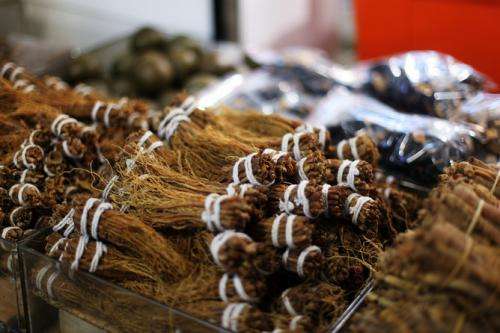In their “natural” form herbal medicines are so variable from batch to batch and across brands that gathering reliable evidence of effectiveness is unlikely ever to be possible. Credit: Mickey_Liaw/Flickr
Natural products can be a source of useful new medicines when the active ingredient is isolated, identified, standardised and subjected to appropriate clinical studies. But in their "natural" form herbal medicines are so variable from batch to batch and across brands that gathering reliable evidence of effectiveness is unlikely ever to be possible.
Indeed, for almost all herbal therapies, it's likely there will never be anywhere near the standard of evidence that's required for prescription medicines.
Standardisation issues
The Therapeutic Goods Administration (TGA) is charged with regulating medicines in Australia, and this includes ensuring their quality and fitness for use.
A large amount of data is required to register new prescription medicines for use in Australia. In the not-too-recent past, a large truck delivered an application to register a new chemical compound. Technology now allows this information to be electronically compressed, but the quantity of data is the same or greater.
These applications to the TGA comprise results of testing for effectiveness and safety in humans and animals, what and whom the compound can treat, and the dose, frequency and duration of treatment.
Supporting these results is information about the chemical content of the batches of medicine used in testing (which chemical and how much), the pharmaceutical properties of the formulations (rate of drug release, for instance), and the stability of the product for the duration of its shelf life.
Without these guarantees of consistency, there's no reasonable likelihood that future batches will lead to the same responses in patients. Indeed, without it the statistical results of clinical studies cannot be relied upon in the future.
But this kind of standardisation of herbal medicines is almost impossible.
Even confirming the identity of a herb is itself often a difficult task because each has multiple varieties, and sometimes the same name is used for different herbs in different countries. The Chinese Pharmacopoeia provides one means of identifying particular herbs but there's little in its monographs to characterise the chemical composition of individual batches.
Variable composition
Like other government bodies, TGA has finite resources so these are allocated according to the risk that medicines could pose to consumers.
Alternative medicines are considered to incur the lowest risk to consumers, subject to defined criteria, and so receive little scrutiny compared with prescription medicines. In assessing the level of risk, TGA considers factors such as side effects, potential harm through prolonged use, toxicity and the seriousness of the medical condition for which the product is intended to be used. But the registration or listing of a herbal medicine doesn't imply that TGA has given its imprimatur to effectiveness or to the consistency of batches in the future.
Indeed, the TGA restricts its scrutiny of herbal medicines to ensuring that the product doesn't cause harm when used to treat a restricted range of conditions. But even this is problematic because herbal and other "natural" medicines are of inherently variable composition. Unpredicted toxicity and interactions with other medicines are always possible.
Consider St John's Wort, which is a relatively well-studied herb. There have been a number of clinical studies about its efficacy and the Cochrane Collaboration has done a review that notes:
St John's Wort products available on the market vary to a great extent.
And that's the heart of the problem – the herb's chemical composition (qualitative and quantitative) varies with its country of origin, harvest time, method of processing, the part of the plant the sample is sourced from (stem, flowers, leaves, buds, or shoots), and how long the harvested plant was stored before use in manufacture.
Its chemical composition has been studied and it is complex. If more than one of its chemical components are active, what are their relative clinical potencies and what ratio of composition leads to an optimum and consistent outcome?
To register and market a new combination of mainstream prescription medicines (the equivalent of a two-component herb), another large dataset must be generated. To require such data for a herbal medicine would be to price it out of the market, even if TGA had the resources to review the submission.
Ultimately, there's no problem with a thriving market for herbal products so long as they're safe and consumers are not misled into using unproven medicines to treat serious conditions and so long as they know that TGA's approval is limited to "do no [known] harm". But because of the lack of standardisation, there will never be anywhere near the quality of clinical evidence for unrefined herbal medicines that's required for prescription medicines.
More information: Linde K, Berner MM, Kriston L. "St John's wort for major depression." Cochrane Database of Systematic Reviews 2008, Issue 4. Art. No.: CD000448. DOI: 10.1002/14651858.CD000448.pub3.
Journal information: Cochrane Library
Source: The Conversation


















